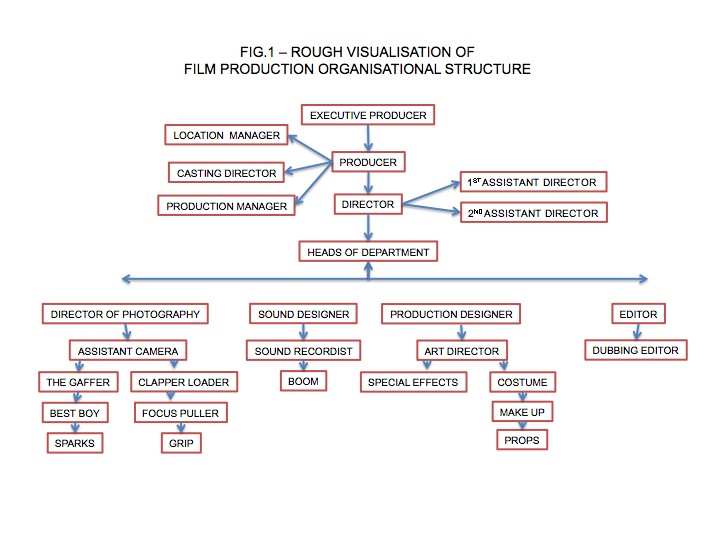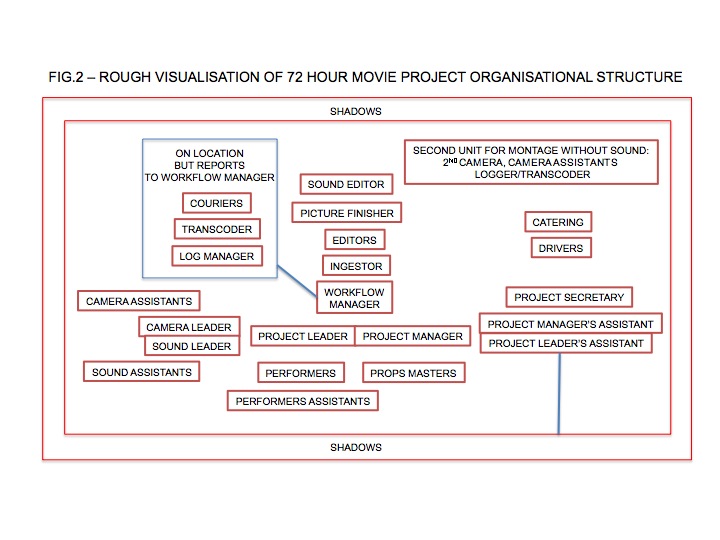Today’s guest post is courtesy of James Fair.
When I wrote ‘Linearity is the Enemy’ for Ted last month, I briefly mentioned how I felt the ‘family tree’ style organisational structure of filmmaking could look more like a ‘mind map’. I want to clarify my point a little further and follow it with why I think it is relevant.
 In Figure 1, I have drawn what many consider to be the model that represents filmmaking structure best. It is a hierarchy of roles that symbolises where the responsibility lies. At the top are the people responsible for the most things, and they then delegate sections of that responsibility to other people ‘below’ them who then assume the responsibility as a proxy. This model is established, tried and tested, and works. It has evolved over time, adding new responsibilities as they emerged, like the sound department. The model was defined early on and has survived political, social and technological changes worldwide. But is it the best model?
In Figure 1, I have drawn what many consider to be the model that represents filmmaking structure best. It is a hierarchy of roles that symbolises where the responsibility lies. At the top are the people responsible for the most things, and they then delegate sections of that responsibility to other people ‘below’ them who then assume the responsibility as a proxy. This model is established, tried and tested, and works. It has evolved over time, adding new responsibilities as they emerged, like the sound department. The model was defined early on and has survived political, social and technological changes worldwide. But is it the best model?
What would constitute the best model? The one that generated most profit? The one that enables the greatest artistic vision to unfold? The one that turned out the most films for the least money, i.e. quantity over quality? Could the best model be the one that reduced the time between concept and completion to months not years? Despite filmmakers working on a project-by-project basis, with numerous different outcomes and motivations, there is currently only one model that consistently gets used. It gets used because it is established, regardless of whether it is the best for the job.
When faced with the challenge of shooting, editing and then screening a feature film in three days as part of the 72 Hour Movie project, I could simply adopt the same model and insist that everyone just works harder and faster than they normally would. Instead, I reassessed all of the responsibilities that would need to occur within the project and reassigned them to whom I felt could do them best. I admit that I have built much of these on the basis of the skill sets that I know various people within my crew possess, as opposed to a model that was built with no knowledge of the crew and then forced onto any given individual. Still, I have altered the roles from their usual titles and given them new responsibilities and remits, designed to support the task of making a film within a short timeframe. As the traditional ‘director’ for example, I have given myself the horribly managerial sounding ‘Project Leader’. I am supported and work closely with Gary Hoctor, the Project Manager (the closest thing to a producer). The strange titles go on throughout the crew, from the obvious (transcoder) to the obscure (shadows). The titles aren’t important – it is the fact that the new roles do not carry the same responsibilities as the existing roles, and therefore they require new titles.
I visualise this organisational structure to be different from the existing model (see Fig.2). Instead of being situated at the top of the project with a series of people ‘underneath’ me, I visualise the Project Manager and I to be at the centre, surrounded by the crew. The roles split out to various other roles, but unlike the vertical communicative routes of the old ‘chain of command’ system, there is a horizontal communication that I believe reflects our collaborative effort more truly. The visual impression of the existing model looks much like a river, with a source and a flow of responsibility towards a delta of runners. It is linear and sequential. The visual impression of the new model reflects a whole entity, in which we are ‘in it’ together, and the process is collaborative. Obviously there is some semblance of order and priority otherwise it is chaos. There is a greater emphasis placed upon the opinion of those closest to the centre, but the need for feedback is factored in to the model, so that the Project Leader or Manager has a greater idea of the effectiveness of the whole effort. I’ve witnessed disgruntled runners as the greatest catalyst of on-set problems under the existing model, damaging morale whilst finding no way of resolving their concerns.
You can dismiss these models as idealistic rubbish if you wish. I imagine I am inviting blog abuse from some of Ted’s readers! You may feel that the design of the model is insignificant as filmmaking operates quite flexibly anyway. I’d agree, but I believe that the titles and the models are not being portrayed as flexible; they are being portrayed as fixed. However you learn about the industry, from educational institutions through to informal training on the job, you are taught ‘how the industry works’, as if it is an unchangeable entity that evolves through necessity to cope with whatever demands are placed upon it. You start at the ‘bottom’ and you work your way ‘up’. Why do we not question it more openly instead of adopting it without a second thought? Yes it may already work, but what if it could work better?
 Thinking differently about the organisational structure means that we might think differently about the process too. A major difference between the existing model and the model that I visualise is that my performers are a part of my crew. I don’t perceive them to be a separate entity just because they are in front of the camera. Perhaps it is the existing distinction that means we treat them differently, and probably why few film schools in the UK teach directors how to work with actors, preferring instead to teach technology. We may begin to think of directors and producers differently too, perhaps like the captain of a sports team instead of a great individual artist (who don’t always give credit to their collaborators). Who knows what differences may emerge from thinking about it differently?
Thinking differently about the organisational structure means that we might think differently about the process too. A major difference between the existing model and the model that I visualise is that my performers are a part of my crew. I don’t perceive them to be a separate entity just because they are in front of the camera. Perhaps it is the existing distinction that means we treat them differently, and probably why few film schools in the UK teach directors how to work with actors, preferring instead to teach technology. We may begin to think of directors and producers differently too, perhaps like the captain of a sports team instead of a great individual artist (who don’t always give credit to their collaborators). Who knows what differences may emerge from thinking about it differently?
Of course, when our 72 Hour Movie project ‘The Ballad of Des & Mo’ goes up onto IMDB as a result of the Melbourne International Film Festival screening, we will have to switch responsibilities back to their nearest equivalent titles, just because the roles are fixed upon their database. This fixed way of thinking means that others may never do things differently, even if it could hold more opportunities for filmmakers.
James is a lecturer in Film Technology at Staffordshire University and is currently in Australia, where he is preparing the 72 Hour Movie project ‘The Ballad of Des & Mo’. The 90-minute film will be shot and edited in three days and then screened to an audience at the Melbourne International Film Festival. Visit www.72hourmovie.com or www.facebook.com/72hourmovie for more details. He openly admits he can’t draw diagrams very well.





